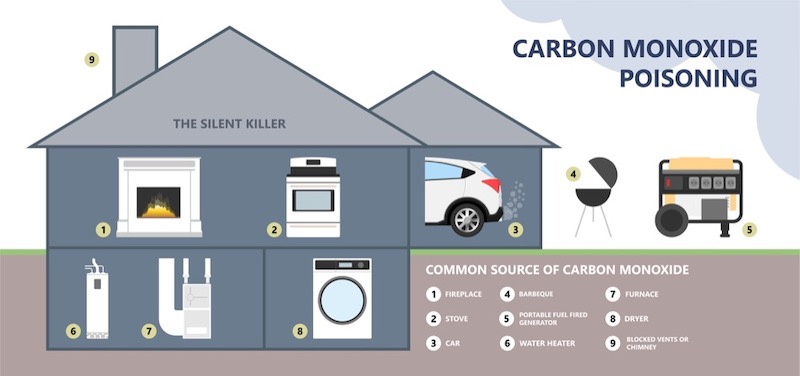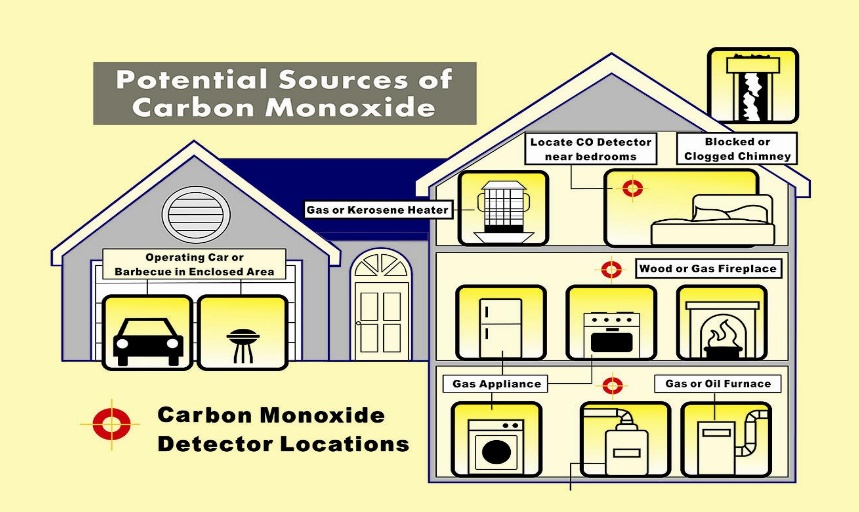What Produces Carbon Monoxide In A House

Many homeowners face the silent threat of carbon monoxide (CO) poisoning. This invisible, odorless, and tasteless gas is a byproduct of incomplete combustion and can be deadly. Recognizing the sources of CO in your home and understanding how to troubleshoot them is crucial for your family's safety. This guide will help you diagnose potential CO sources and address some common issues. However, remember that CO is extremely dangerous, and if you suspect a leak or feel unwell, evacuate immediately and call 911.
Understanding Carbon Monoxide Sources
Before diving into troubleshooting, it's essential to understand the common culprits that produce CO in a home. These typically involve fuel-burning appliances and equipment.
Common CO Producers:
- Furnaces: Malfunctioning or poorly maintained furnaces are a primary source.
- Water Heaters: Gas-powered water heaters can produce CO if not properly ventilated.
- Fireplaces: Wood-burning fireplaces, if not properly vented or cleaned, can release CO into the house.
- Gas Stoves and Ovens: While designed for cooking, they can emit CO, especially if burners are improperly adjusted.
- Portable Generators: *Never* operate a generator indoors or in an attached garage. This is a leading cause of CO poisoning.
- Cars and Trucks: Running a vehicle in an attached garage, even for a short time, can allow CO to seep into your home.
- Kerosene or Propane Space Heaters: Use these only in well-ventilated areas and according to the manufacturer's instructions.
- Charcoal Grills: Similar to generators, charcoal grills should *never* be used indoors.
Step-by-Step Troubleshooting Guide
This guide provides a systematic approach to identifying and addressing potential CO sources. Always prioritize safety and err on the side of caution.
Step 1: Confirming a CO Problem
The first step is to verify if there's actually a CO problem. Symptoms of CO poisoning can mimic the flu. If you suspect a CO leak, take these immediate actions:
- Evacuate: Get everyone out of the house immediately.
- Call 911: Alert emergency services and report your concerns.
- Don't Re-enter: Do not go back into the house until cleared by professionals.
Once the area is safe (confirmed by fire department or other qualified personnel), check your CO detectors. Every home should have working CO detectors on each level and near sleeping areas. Make sure the batteries are fresh, and the detectors are within their lifespan (usually 5-7 years). Replace them if needed.
Step 2: Inspecting Your Furnace
The furnace is often the primary suspect. Here's how to check it:
- Visual Inspection: Look for signs of rust, soot, or physical damage around the furnace and its flue pipe (the pipe that vents exhaust outside).
- Flue Pipe Integrity: Ensure the flue pipe is securely connected to both the furnace and the chimney. Check for any gaps, cracks, or disconnections. Even small gaps can leak CO.
- Pilot Light (if applicable): A properly burning pilot light should be blue. A yellow or flickering flame indicates incomplete combustion.
- Filter Check: A dirty air filter restricts airflow, which can cause the furnace to work harder and produce more CO. Replace the filter regularly (every 1-3 months).
- Filter Replacement: Replacing a dirty air filter is a simple DIY task.
- Pilot Light Adjustment (if you're comfortable): Carefully adjust the pilot light according to the manufacturer's instructions. *Turn off the gas supply before attempting this if you're unsure.*
- Cracks or Damage: If you see any cracks in the heat exchanger or physical damage to the furnace, call a qualified HVAC technician immediately.
- Flue Pipe Issues: If you can't securely reconnect the flue pipe or notice significant rust or corrosion, it's time for a professional.
- Persistent Yellow Flame: If the pilot light continues to burn yellow after adjustment, a professional is needed.
- Soot or Black Residue: The presence of soot indicates a serious problem requiring immediate attention.
Step 3: Examining Your Water Heater
Gas-powered water heaters are another potential source of CO. Here's what to look for:
- Visual Inspection: Similar to the furnace, check for rust, soot, or damage around the water heater and its flue pipe.
- Flue Pipe Connection: Ensure the flue pipe is properly connected and free of obstructions.
- Flame Color: The burner flame should be blue. A yellow or orange flame indicates incomplete combustion.
- Ventilation: Make sure the area around the water heater is well-ventilated. Do not block the air vents.
- Cleaning Burners: Carefully clean the burners with a wire brush to remove any debris that might be causing incomplete combustion. *Turn off the gas supply before attempting this.*
- Rust or Corrosion: Significant rust or corrosion on the water heater tank or flue pipe requires professional attention.
- Persistent Yellow Flame: If the burner flame remains yellow or orange after cleaning, call a qualified technician.
- Strange Noises: Unusual noises coming from the water heater can indicate a serious problem.
- Pilot Light Issues: Difficulty lighting or keeping the pilot light lit warrants a professional inspection.
Step 4: Checking Your Fireplace
Fireplaces, especially wood-burning ones, can be a source of CO if not properly maintained.
- Chimney Inspection: Have your chimney professionally inspected and cleaned annually. Creosote buildup can restrict airflow and increase CO production.
- Damper Operation: Ensure the damper is fully open before lighting a fire and remains open until the embers are completely extinguished.
- Proper Wood Burning: Use only seasoned, dry wood. Wet or green wood produces more smoke and CO.
- Smoke Backdraft: If you notice smoke backing up into the room, it indicates a problem with the chimney draft.
- Damper Check: Make sure the damper is functioning correctly and not obstructed.
- Cleaning the Firebox: Regularly clean out ashes and debris from the firebox.
- Chimney Inspection/Cleaning: As mentioned earlier, annual chimney inspections and cleanings are crucial.
- Smoke Backdraft: A persistent smoke backdraft requires immediate professional attention.
- Damaged Chimney: Cracks or damage to the chimney structure can be dangerous.
Step 5: Addressing Gas Stoves and Ovens
Gas stoves and ovens can produce CO, especially if not properly adjusted.
- Flame Color: The burner flames should be blue. Yellow or orange flames indicate incomplete combustion.
- Burner Cleaning: Clean the burners regularly to remove food debris that might be obstructing airflow.
- Ventilation: Use the range hood when cooking to vent fumes outside.
- Burner Cleaning: Use a wire brush or pin to clear any clogs in the burner ports.
- Persistent Yellow Flame: If the flames remain yellow or orange after cleaning, a professional gas appliance technician is needed to adjust the burner settings.
- Gas Leaks: If you smell gas, evacuate immediately and call your gas company.
- Oven Malfunctions: Any malfunctions in the oven's heating system should be addressed by a qualified technician.
Step 6: Generator Safety (Important!)
Generators are extremely dangerous and should never be operated indoors or in an attached garage.
- Outdoor Operation: Place the generator at least 20 feet away from your house and any windows or doors.
- Direction: Position the generator so that the exhaust fumes are directed away from the house.
- CO Detectors: Ensure you have working CO detectors in your home.
Step 7: Vehicle Safety
Never run a vehicle in an attached garage, even with the garage door open. CO can quickly build up and seep into your home.
There are *no* DIY fixes for this. Always start and run vehicles outdoors.Preventive Measures
Prevention is key to avoiding CO poisoning. Implement these measures to keep your home safe:
- Install CO Detectors: Place CO detectors on every level of your home and near sleeping areas. Test them regularly and replace the batteries twice a year. Replace detectors every 5-7 years, as recommended by the manufacturer.
- Annual Inspections: Have your furnace, water heater, and fireplace professionally inspected and serviced annually.
- Regular Maintenance: Replace air filters regularly, clean burners on gas stoves, and ensure proper ventilation in your home.
- Educate Your Family: Teach everyone in your household about the dangers of CO poisoning and the symptoms to watch out for.
When to Call a Professional - A Recap
While some issues can be addressed with simple DIY fixes, it's crucial to know when to call a professional. Here's a summary of situations requiring expert intervention:
- Any time you suspect a CO leak or experience symptoms of CO poisoning. Evacuate and call 911 immediately.
- Cracks, damage, or significant rust on furnaces, water heaters, or chimneys.
- Persistent yellow or orange flames on gas appliances after cleaning.
- Difficulty lighting or keeping pilot lights lit.
- Smoke backdraft from a fireplace.
- Gas leaks.
- Oven malfunctions.
By understanding the sources of CO, following these troubleshooting steps, and prioritizing safety, you can help protect your family from this silent killer. Remember, when in doubt, always call a qualified professional. Your safety is paramount.










